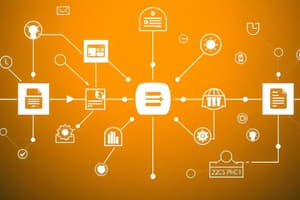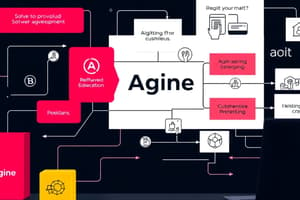Podcast
Questions and Answers
Which activity is typically the FIRST to occur in the waterfall model?
Which activity is typically the FIRST to occur in the waterfall model?
- Operation and maintenance
- Requirements analysis and definition (correct)
- Implementation and unit testing
- System and software design
Which of the following is a KEY characteristic of agile processes?
Which of the following is a KEY characteristic of agile processes?
- Changes are resisted to maintain stability
- Extensive documentation is prioritized
- Detailed planning is completed upfront
- Planning is incremental and adapts to changing needs (correct)
Which statement BEST describes a software process model?
Which statement BEST describes a software process model?
- An abstract representation of a software development process (correct)
- A detailed list of project tasks and timelines
- A specific programming language used in a project
- A contract between the client and the development team
What is the PRIMARY goal of software validation?
What is the PRIMARY goal of software validation?
Which of the following is NOT one of the basic process activities?
Which of the following is NOT one of the basic process activities?
Which of the following is a potential BENEFIT of incremental development?
Which of the following is a potential BENEFIT of incremental development?
What is a KEY challenge associated with the waterfall model?
What is a KEY challenge associated with the waterfall model?
In reuse-oriented software engineering, what does COTS stand for?
In reuse-oriented software engineering, what does COTS stand for?
Which testing type focuses on verifying the system meets customer's needs, using real data?
Which testing type focuses on verifying the system meets customer's needs, using real data?
Why is software evolution a critical part of the software lifecycle?
Why is software evolution a critical part of the software lifecycle?
What is the PRIMARY purpose of a system prototype?
What is the PRIMARY purpose of a system prototype?
How does 'change tolerance' differ from 'change avoidance' in software development?
How does 'change tolerance' differ from 'change avoidance' in software development?
In the context of software process descriptions, what do 'roles' define?
In the context of software process descriptions, what do 'roles' define?
Which of the following is a DISADVANTAGE of incremental delivery?
Which of the following is a DISADVANTAGE of incremental delivery?
Which factor makes the waterfall model MOST suitable for large systems engineering projects?
Which factor makes the waterfall model MOST suitable for large systems engineering projects?
Which of the following activities is typically part of the 'requirements engineering process'?
Which of the following activities is typically part of the 'requirements engineering process'?
What is the PRIMARY goal of 'architectural design' in software development?
What is the PRIMARY goal of 'architectural design' in software development?
Which choice BEST describes the spiral model’s approach to managing changes in software projects?
Which choice BEST describes the spiral model’s approach to managing changes in software projects?
Which perspective is NOT typically used to describe the Rational Unified Process?
Which perspective is NOT typically used to describe the Rational Unified Process?
What is the MAIN objective of the 'inception' phase in the Rational Unified Process (RUP)?
What is the MAIN objective of the 'inception' phase in the Rational Unified Process (RUP)?
In the context of software process models, what does 'interleaved' mean?
In the context of software process models, what does 'interleaved' mean?
How does Boehm's spiral model address the limitations of the waterfall model?
How does Boehm's spiral model address the limitations of the waterfall model?
Which statement accurately contrasts incremental development and reuse-oriented software engineering?
Which statement accurately contrasts incremental development and reuse-oriented software engineering?
In the transition from software design to implementation, what is the MOST critical factor?
In the transition from software design to implementation, what is the MOST critical factor?
What is the MOST significant implication of 'throw-away prototypes'?
What is the MOST significant implication of 'throw-away prototypes'?
Which of the following testing methodologies MOST effectively tests emergent properties?
Which of the following testing methodologies MOST effectively tests emergent properties?
Given a project with well-defined, unchanging requirements, which process model is MOST suitable?
Given a project with well-defined, unchanging requirements, which process model is MOST suitable?
What makes system prototyping effective at reducing the cost of rework?
What makes system prototyping effective at reducing the cost of rework?
If you have a project with poorly defined and changing requirements, what process model is the MOST suitable?
If you have a project with poorly defined and changing requirements, what process model is the MOST suitable?
What activity would occur in the Elaboration phase of RUP?
What activity would occur in the Elaboration phase of RUP?
What does the spiral model combine to implement change?
What does the spiral model combine to implement change?
What process is used to establish the services required and constraints on a system?
What process is used to establish the services required and constraints on a system?
What are the software process descriptions?
What are the software process descriptions?
What are the 4 design activities that define the design process?
What are the 4 design activities that define the design process?
Which is NOT one of the benefits of software prototyping?
Which is NOT one of the benefits of software prototyping?
Which of the following is NOT one of the ways that a prototype can be used in the software development cycle?
Which of the following is NOT one of the ways that a prototype can be used in the software development cycle?
During which stage of a software project is the identification of the system's components and their relationships MOST critical?
During which stage of a software project is the identification of the system's components and their relationships MOST critical?
A development team is using incremental delivery, but have a hard time getting honest feedback because the users keep stating they want all of the functionality. What activity can take place to resolve this issue?
A development team is using incremental delivery, but have a hard time getting honest feedback because the users keep stating they want all of the functionality. What activity can take place to resolve this issue?
A software company decides the software team will experiment with a prototype and refine the requirements. What is this considered?
A software company decides the software team will experiment with a prototype and refine the requirements. What is this considered?
Flashcards
Software Process
Software Process
A structured set of activities required to develop a software system.
Software Specification
Software Specification
Defining what the software should do.
Design and Implementation
Design and Implementation
Defining the organization of the system and implementing that system.
Validation
Validation
Signup and view all the flashcards
Evolution
Evolution
Signup and view all the flashcards
Software Process Model
Software Process Model
Signup and view all the flashcards
Plan-Driven Processes
Plan-Driven Processes
Signup and view all the flashcards
Agile Processes
Agile Processes
Signup and view all the flashcards
Waterfall Model
Waterfall Model
Signup and view all the flashcards
Incremental Development
Incremental Development
Signup and view all the flashcards
Reuse-Oriented Software Engineering
Reuse-Oriented Software Engineering
Signup and view all the flashcards
Software Specification
Software Specification
Signup and view all the flashcards
Feasibility Study
Feasibility Study
Signup and view all the flashcards
Requirements Elicitation and Analysis
Requirements Elicitation and Analysis
Signup and view all the flashcards
Requirements Specification
Requirements Specification
Signup and view all the flashcards
Requirements Validation
Requirements Validation
Signup and view all the flashcards
Software Design and Implementation
Software Design and Implementation
Signup and view all the flashcards
Architectural Design
Architectural Design
Signup and view all the flashcards
Interface Design
Interface Design
Signup and view all the flashcards
Component Design
Component Design
Signup and view all the flashcards
Database Design
Database Design
Signup and view all the flashcards
Software Validation (V & V)
Software Validation (V & V)
Signup and view all the flashcards
Component Testing
Component Testing
Signup and view all the flashcards
Software Prototyping
Software Prototyping
Signup and view all the flashcards
Acceptance Testing
Acceptance Testing
Signup and view all the flashcards
System Testing
System Testing
Signup and view all the flashcards
Software Evolution
Software Evolution
Signup and view all the flashcards
Inevitable Software Changes
Inevitable Software Changes
Signup and view all the flashcards
Change Avoidance
Change Avoidance
Signup and view all the flashcards
Change Tolerance
Change Tolerance
Signup and view all the flashcards
Prototype
Prototype
Signup and view all the flashcards
Prototypes Benefits
Prototypes Benefits
Signup and view all the flashcards
Throw-away Prototype
Throw-away Prototype
Signup and view all the flashcards
Incremental Delivery
Incremental Delivery
Signup and view all the flashcards
In-Phase Iteration
In-Phase Iteration
Signup and view all the flashcards
Boehm's Spiral Model
Boehm's Spiral Model
Signup and view all the flashcards
Objective Setting
Objective Setting
Signup and view all the flashcards
Rational Unified Process
Rational Unified Process
Signup and view all the flashcards
Inception (RUP)
Inception (RUP)
Signup and view all the flashcards
Elaboration (RUP)
Elaboration (RUP)
Signup and view all the flashcards
Study Notes
Software Processes Overview
- Software processes consist of structured activities to develop a software system.
- Multiple software processes exist, commonly involving specification, design, implementation, validation, and evolution.
- A software process model offers an abstract representation of a process from a specific viewpoint.
- Software process descriptions detail activities like specifying data models or designing user interfaces.
- Process descriptions can include products, roles, and pre- and post-conditions.
Plan-Driven vs. Agile Processes
- Plan-driven processes involve advance planning of all activities with progress measured against the plan.
- Agile processes use incremental planning, adapting to evolving customer needs.
- Practical processes often blend plan-driven and agile elements, and no software process is inherently superior to another.
Software Process Models
- The waterfall model is plan-driven, segmenting activities into distinct phases like requirement specification, design, implementation, and testing.
- Incremental development interleaves specification, development, and validation, possibly being plan-driven or agile.
- Reuse-oriented software engineering uses existing components to assemble the system and can be plan-driven or agile.
- Most large systems utilize a development approach that combines aspects of all the models.
Waterfall Model
- Involves distinct phases: requirements analysis/definition, system/software design, implementation/unit testing, integration/system testing, operation/maintenance.
- It can be difficult to accommodate changes mid-process, requiring phase completion before moving forward.
- Partitioning projects into inflexible stages hinders adapting to changing customer needs.
- It is appropriate when a project's requirements are well-understood with limited changes during design.
- It is often used for large systems developed across multiple locations as its plan-driven nature aids work coordination.
Incremental Development
- Reduces costs for accommodating changing customer needs.
- Generates less analysis and documentation than the waterfall model.
- Facilitates customer feedback on development with software demonstrations.
- Makes rapid software deployment possible for customers.
- Allows earlier customer use and value gain compared to the waterfall process.
- Can suffer from a lack of visibility and can be costly to produce documents that reflect every version of the system.
- The system's structure can be compromised as increments are added.
Reuse-Oriented Software Engineering
- A systematic approach that integrates pre-existing components or COTS (Commercial-off-the-shelf) systems.
- Process steps include component analysis, requirements modification, system design with reuse, development, and integration.
- Component types include web services with standard-based remote invocation, object collections for integration (.NET, J2EE), and configurable standalone systems (COTS).
Process Activities
- Real software processes interleave technical, collaborative, and managerial activities.
- They are aimed at specifying, designing, implementing, and testing software systems.
- Specification, development, validation, and evolution activities are organized differently based on the development process.
Software Specification
- Establishes needed services and system constraints.
- The requirements engineering process involves feasibility studies, requirements elicitation/analysis, specification, and validation.
Software Design and Implementation
- Converts system specifications into executable systems.
- Software design involves designing a structure that realizes the specification.
- Implementation involves translating this structure into a program.
- Design and implementation are closely related and may be interleaved.
Design Activities
- Architectural design identifies the system's overall structure and components, defining their overall relationships .
- Interface design defines interfaces between system components.
- Component design details the operation of each system component.
- Database design focuses on the system data structures and representation in a database.
Software Validation
- Verification and validation (V & V) shows that a system adheres to its specification and customer needs.
- V & V includes checking, reviewing, and system testing.
- Testing executes the system using test cases derived from real data specifications.
- Testing is the most common V & V activity.
Testing Stages
- Development/component testing focuses on individual components. These components are tested independently.
- System testing tests the whole system and emergent properties.
- Acceptance testing checks if the system meets customer needs with real data.
Software Evolution
- Software is flexible and adaptable.
- Software must evolve and be useful as business circumstances and requirements change.
Coping with Software Changes
- Change is unavoidable in big software projects.
- Business changes result in new system demands.
- New technology provides opportunities for implementation improvements.
- Changing platforms will require application modifications.
- Addressing change involves reworking, raising costs and requiring new functionality considerations.
- System prototyping and incremental delivery are two ways to deal with changes and evolving requirements.
Reducing Rework Costs
- Change avoidance incorporates activities to anticipate changes, reducing rework. Developing prototype systems and refining requirements with customer feedback aids in that anticipation.
- Change tolerance designs the process to accommodate changes at a lower cost, often through incremental development.
- Proposed changes can be made to undeveloped increments, or a smaller system may be changed to incorporate modifications.
Software Prototyping
- An initial system version used to show ideas and test design choices.
- Prototyping can assist with requirements engineering, validation, exploring design options, and testing.
- Prototyping provides key benefits like improved system usability, closer user need alignment, improved design quality, enhanced maintainability, and reduced development efforts.
Prototype Development
- It may rely on rapid prototyping languages or tools.
- May leave out functionality.
- Prototype highlights areas not fully understood, it may overlook error checking or prioritize functional over non-functional reliability/security issues.
Throwaway Prototypes
- Prototypes may be discarded post-development because they might lack suitability for production.
- Tuning systems to fulfill functional needs could be difficult.
- Prototypes may lack documentation, exhibit degraded structure, and fail to satisfy quality standards.
Incremental Delivery
- Development breaks down into increments, each providing functionality, instead of delivering as one package.
- Prioritizes user needs, addressing peak requirements into earlier deployments.
- Continues assessment with the aim being requirements for subsequent phases.
Incremental Development and Delivery
- Incremental development develops and evaluates each increment before moving on to the next. It is commonly used in agile methods and uses user/customer evaluations.
- Incremental delivery deploys increments for end-user application, giving practical use evaluation, but may be arduous to incorporate as replacements due to minimal capacity.
Incremental Delivery Advantages
- Customer value emerges throughout with functionality available immediately.
- Early increments are prototypes to formulate additional phase requests.
- Lower chance of total cancellation as well as most tested system programs.
Incremental Delivery Problems
- Rework can be difficult with replacement systems due to user resistance.
- Complete user needs with the original framework makes reception difficult.
- System model conflicts with acquisition model.
- Contract requires complete system setup.
Boehm's Spiral Model
- A risk-driven framework created by Boehm replaces the common activity-based sequence with a spiral shape.
- Each spiral cycle embodies phase-specific models, which combines change avoidance with tolerance centered on project risks and management.
- Risks must be defined, measured and adapted, which is part of reduction activities.
Spiral Model Sectors
- Establish concrete targets for progress toward development while decreasing main concerns throughout activity establishment.
- Choose system development that conforms to model through generic forms to meet validation.
- Analyze planned processes by assessing project stage relative to the cycle.
Spiral Model Usage
- The spiral is influential among people.
- Thinks of stages during iterative model creation through implementing hazard driving, yet it has never been directly applied for use in common cases.
The Rational Unified Process
- Is a modern process taken from UML practices and is supported by aspects of past procedures.
- Is analyzed from three angles, or time driven displays, process activity and exercise supported practice.
RUP Phases
- System cases are developed to highlight the process, understanding sphere and development creation through programs/testing.
- A transition deploys into an operating context.
RUP Iteration
- Every point is developed during gradual iteration. The model enacts full sets of increments in succession.
Studying That Suits You
Use AI to generate personalized quizzes and flashcards to suit your learning preferences.




